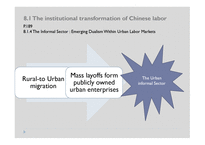CHINESEE CONOMY
 등록일 / 수정일
등록일 / 수정일 페이지 / 형식
페이지 / 형식 자료평가
자료평가 구매가격
구매가격
- 2016.04.16 / 2016.04.16
- 51페이지 /
 pptx (파워포인트 2007이상)
pptx (파워포인트 2007이상) - 평가한 분이 없습니다. (구매금액의 3%지급)
- 1,000원
최대 20페이지까지 미리보기 서비스를 제공합니다.
자료평가하면 구매금액의 3%지급!
 1
1 2
2 3
3 4
4 5
5 6
6 7
7 8
8 9
9 10
10 11
11 12
12 13
13 14
14 15
15 16
16 17
17 18
18 19
19 20
20
추천 연관자료
- 본문내용
-
TEAM 6
CHINES ECONOMY
LIST
UNIT 8. LABOR AND HUMAN CAPITAL
UNIT 9. LIVING STANDARDS
UNIT 8
LABOR AND
HUMAN CAPITAL
8.1 The institutional transformation of Chinese labor
8.1 The institutional transformation of Chinese labor
P.182
8.1.2 Employment: Ownership and Labor Mobility
The government assumed direct control over all urban hiring. ( They took authority to hire and fire away from individual enterprises
Voluntary job mobility within urban areas disappeared.
This complete absence of labor markets was an extraordinary feature of the Chinese command system.
The extra rigidity of labor markets grew out of the effort to control population movement and employment after the GLF
In the 1960~1970s : There was virtually no labor mobility .
After the collapse of the GLF, mobility of all kinds, including job mobility, declined sharply.
8.1 The institutional transformation of Chinese labor
8.1.2 Employment: Ownership and Labor Mobility
<Conclusion>
8.1 The institutional transformation of Chinese labor
P.182
8.1.2 Employment: Ownership and Labor Mobility
Thereafter, the Chinese government began to give greater legitimacy and legal protection to private enterprise.
As of 2003, almost 5% of the Chinese labor force works for the government-run PSUs.
Deducting government and public enterprise workers, more than 80% of China’s workers work for the private sector.
Both in urban and rural areas are an extremely important part of labor markets.
Through the mid-1990s, the features of the first phase of china’s gradualist transition strategy were very much in evidence.
This whole institutional setup changed dramatically. SOEs began laying off redundant workers.
8.1 The institutional transformation of Chinese labor
8.1.2 Employment: Ownership and Labor Mobility
<Conclusion>
8.1 The institutional transformation of Chinese labor
P.184
8.1.3 Employment, Unemployment, and State-Sector Downsizing
At the beginning of the reform era (1978-1979), millions of the “sent down” youth returned to the city and had to find work.
During the mid-1990s the dramatic acceleration of labor reforms began with the determination of tackle the problem of overmanning in SOEs.
New categories of workers : the “surplus worker” and subsequently, “off-post” or “laid-off” (xiagang) worker.
WHAT is 下 Xiagang ?
The Chinese language xiagang means “not on sentry duty”
but the word is now widely used as a special term to indicate circumstances where a worker is no longer “on duty”
in his or her work unit.
Warner and Zhu (2000) describe xiagang as internal unemployment,
which occurs when SOEs are downsized and the employees
for whom there is no longer work are provided with a stipend and entitlements such as housing and medical benefits.
Xiagang was designed to fit the special circumstances of the transitional economy and avoid the distinguished the Russian model.
The process was quite different from redundancy
in advanced industrial economies.
The SOE retained a concrete set of obligations to laid off
employees as well as a formal, albeit pared down,
labor relationship for a maximum period of three years.
8.1 The institutional transformation of Chinese labor
P.187
8.1.3 Employment, Unemployment, and State-Sector Downsizing
자료평가
-
아직 평가한 내용이 없습니다.
회원 추천자료
오늘 본 자료
더보기

최근 판매 자료
- [국제통상론] 한국-EU간 주세 酒稅 분쟁사건 의미와 향후 전망
- 소비자심리학 레포트
- (경영학]헤어의 역사와 헤어펌의 종류 및 커트의 종류 분석조사)
- [경제학이론] 부당한 공동행위(카르텔)
- 중국 비즈니스 연구 - 이마트의 중국 진출 실패 - 1 5C 시장 환경 분석 2 VMS 설정 3 STP 전략 수립 4 SWOT 전략 수립 5 5P 전술 운용
- 포터의 경쟁세력모형 이론에 대해 설명하고, 관심 산업분야에서 새로운 정보기술에 의한 산업변화를 경쟁세력모형을 이용하여 설명하시오.
- [호텔경영] 신라&메리어트 호텔의 조직 구성도
- 상쾌환PPT(숙취해소제 환 제품군 TOPof MIND 제고를 위한 IMC전략)
- POSCO의 글로벌 인적자원관리 사례
- [경영,경제] 재고자산 평가방법 비교
저작권 관련 사항 정보 및 게시물 내용의 진실성에 대하여 레포트샵은 보증하지 아니하며, 해당 정보 및 게시물의 저작권과 기타 법적 책임은 자료 등록자에게 있습니다. 위 정보 및 게시물 내용의 불법적 이용, 무단 전재·배포는 금지됩니다. 저작권침해, 명예훼손 등 분쟁요소 발견시 고객센터에 신고해 주시기 바랍니다.









